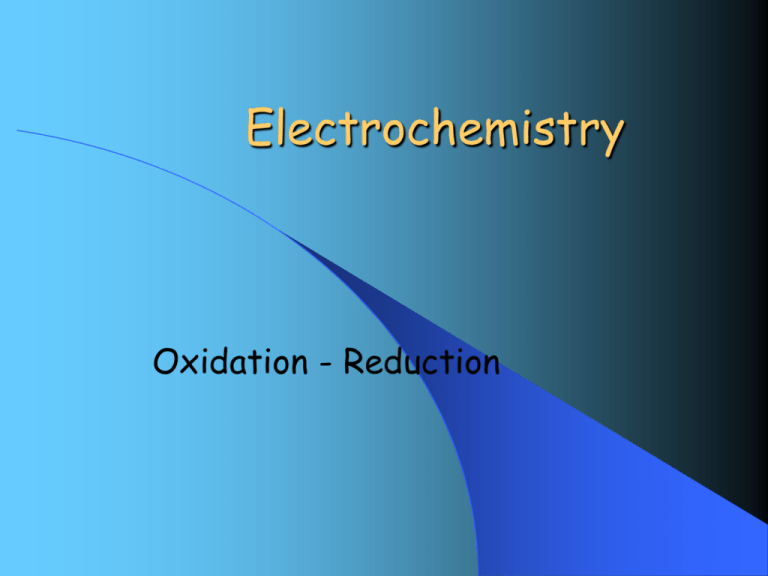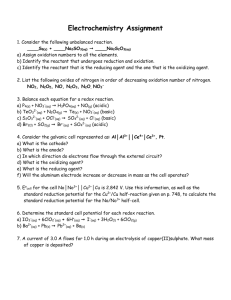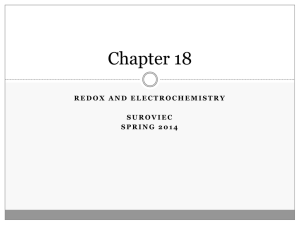Redox 10 - BC Learning Network
advertisement

Electrochemistry Oxidation - Reduction Table of Contents Section 1 Introduction Section 2 Oxidation Numbers Section 3 Predicting Spontaneity of a Redox Reaction Questions to think About What element must be present for carbon to burn? What element must be present in order for rusting to occur? Can you think of a name or a term for turning FeS or Al2O3 into the element Fe or the element Al? Are you adding or subtracting something during this process? What happens when? Solid copper is put in AgNO3? 2. Write an equation. 3. What is happening to the solution? 4. What is happening to the copper? Watch the demo and think about what you see? 1. The Demo Describe what happened to the solution. Describe what happened to the copper. Can you make an equation to show the ions that are still in solution and the metal forming on the copper wire? The equation 2AgNO3 (aq) + Cu(a) CuNO3(aq) 2Ag(s) + Write the net ionic equation for this reaction. Where is the silver when it is a reactant? Where is the silver when it is a product? Where is the copper when it is a reactant? Where is the copper when it is a product? What happened to the nitrate? Net ionic equation: 2Ag+ (aq)+ Cu(a) 2Ag(s) + Cu2+(aq) How many protons and electrons there in Ag+ (aq)? How many protons and electrons there in Ag(s)? How many protons and electrons there in Cu(s)? How many protons and electrons there in Cu2+? are are are are What do you notice about the electrons in the reactants and the products? What is electricity? How does electricity come into your house? How does electricity come from a battery? Section 1 -Introduction Electrochemistry – the branch of chemistry which is concerned with the conversion of chemical energy into electrical energy and vice versa.(Hebden, p. 189) Oxidation – reduction reactions – Two kinds of reactions – Always occur together – Involve the loss or gain of electrons Oxidation A reaction that involves the loss of electrons Example Complete equation, net ionic equation, oxidation equation 2AgNO3 (aq) + Cu(a) 2Ag(s) + CuNO3(aq) 2Ag+ (aq)+ Cu(a) 2Ag(s) + Cu2+(aq) Cu(a) Cu2+(aq)+ 2e- Reduction A reaction that involves the gain of electrons Reduction Example Example: Complete equation, net ionic equation, reduction equation 2AgNO3 (aq) + Cu(a) 2Ag(s) + CuNO3(aq) 2Ag+ (aq)+ Cu(a) 2Ag(s) + Cu2+(aq) 2Ag+ (aq)+ 2e- 2Ag(s) Memory Aid LEO the lion says GER LEO = Loss of Electrons is Oxidation GER = Gain of Electrons is Reduction (Hebden, p. 190) Oxidizing Agent The species that causes the oxidation The species that gets reduced Look for the species whose oxidation number (looks like a charge) is reduced Example 2Ag+(aq)+ Cu(a) 2Ag(s) + Cu2+(aq) 2Ag+(aq) is the oxidizing agent – it changes from 2Ag+(aq) to 2Ag(s) Ag+(aq) to Ag(s) – changes from +1 to 0 or no number, changes from an ion to a metal Reducing Agent The species that causes the reduction The species that gets oxidized Look for the species whose oxidation number (looks like a charge) is increased. Example 2Ag+(aq)+ Cu(a) 2Ag(s) + Cu2+(aq) Cu(a) is the reducing agent – it changes from Cu(a) to Cu2+(aq) Cu(a) to Cu2+(aq)– changes from 0 (no number) to 2+ - changes from a metal to an ion Redox Reactions Any time an atom or an ion changes its charge during a reaction a redox reaction has occurred. Recognizing Oxidation Reactions Oxidized species become more positive because they lose electrons They have fewer electrons as a product than they had as a reactant Protons > electrons as a product Cu(a) Cu2+(aq)+ 2e See examples of oxidation reactions (half-reactions) page 191 in Hebden Recognizing Reduction Reactions Reduced species become more negative because they gain electrons They have more electrons as a product than as a reactant Protons < electrons as product Ag+ (aq)+ e- 2Ag(s) See examples of reduction reactions (half-reactions) page 191 in Hebden In a redox reaction: you should be able to 1. 2. 3. 4. Identify the oxidizing agent Identify the reducing agent Identify the species being oxidized Identify the species being reduced 5. 6. 7. 8. Write complete balanced equations Write net ionic equations Write reactions (half-reactions) for oxidation Write reactions (half-reactions) for reduction Practice Go to the following websites to review and practice World of Chemistry: The Home Page of Ralph Logan at http://members.aol.com/logan20/agents.html http://hyperphysics.phyastr.gsu.edu/hbase/chemical/redoxcon.html#c1 Section 2 – Oxidation Numbers An arbitrary system Used by chemists so they can describe what happens in Redox reactions It is the charge an ion would have if the species containing the atom were made up of ions (Hebden, p. 193) Assumptions All group 1 elements (alkali metals) have oxidation numbers of 1+ All group 2 elements (alkaline earth metals) have oxidation numbers of 2+ Oxygen is USUALLY 2 Hydrogen is USUALLY 1+ - not when in a metallic hydride NaH, or BaH2 All group 17 (halogens) have oxidation numbers of 1- but there are many exceptions NEUTRAL ATOMS – ATOMS IN THEIR ELEMENTAL FORM ARE ZERO Rule for calculating Oxidation Numbers (ON’s) THE SUM OF THE POSITIVE OXIDATION NUMBERS AND THE NEGATIVE OXIDATION NUMBERS MUST EQUAL THE OVERALL CHARGE ON THE SPECIES Examples See page 625 in Heath See page 626 in Hebden Go to this website to for a tutorial and to practice assigning Oxidation Numbers Assigning Oxidizing Numbers Instructor: Dr. Angela G. King Programming & Design: Yue-Ling Wong Chemistry Department, Wake Forest University http://www.wfu.edu/~ylwong/redox/assignoxid-num/ Section 3- Predicting the Spontaneity of a Redox Reaction Use the Standard Reduction Potentials Table IT IS VERY SIMILAR TO THE TABLE OF RELATIVE STRENGTHS OF ACIDS Table of Standard Reduction Potentials Metals are on the bottom half on the right EXCEPT FOR FOR THIS CLUSTER – – – – Cu Ag Hg Au Halogens are in the top half Oxyanions – anions that have oxygen are in the top half Some metals like Fe, Sn, Cr, Hg, Cu have more than one oxidation number so they are on both sides of the table – find copper on the table – see how many times you can find it and make sure you notice the side of the table Fe, Sn, Cr, Hg, Cu Some metals like Fe, Sn, Cr, Hg, Cu have more than one oxidation number they are on both sides of the table Find copper on the table –How many times do you see Cu+, Cu2+, Cu(s)? What sides of the table are they on each time? Is it always the same? H2O 2 Look for H2O2 on the table. Where is it on the left side – top or bottom? How much is its potential? Where is it on the right side – top or bottom? How much is its potential? Reaction Tendencies Species on the upper left – tend to go forward Species on the lower right – tend to go in reverse Writing Half-Reactions Isolated half reactions – write with a double arrow Half reactions made to undergo reduction or oxidation use a single arrow On the table – oxidation reactions can be thought of as written backwards (reverse reactions) When you write an equation you must turn the oxidation reaction around Example For the reaction of Cu2+ and Zn Cu2+ + 2e- Cu (reduction reaction) Zn Zn2+ + 2e-(oxidation reaction) Cu2+ + 2e- Cu Zn Zn2+ + 2e Cu2+ + Zn Cu + Zn2+ Oxidation or Reduction? If two half-cells (or half reactions) are joined, the higher half reaction on the Table will undergo reduction and the lower one will undergo oxidation (Hebden, p. 196) In a redox half-reactions there are two species that can reduce and two species that can oxidize. Find the potential reducing species that is highest on the table, that is the one that will make the reduction half-reaction Find the potential oxidizing species that is lowest on the table, that is the one that will make the oxidizing half-reaction Predicting Spontaneity 1. 2. Given two potential reactions Find the reactants on the table Check to see which side the reactants are on Spontaneous Reactions If one reactant is on the left and one is on the right sides of the table, a reaction will be spontaneous if the one on the left, the oxidizing agent, is higher on the table (above) than the one on the right, the reducing agent. Non Spontaneous Reactions 1. 2. If both reactants are on the same side the reaction will not occur If one reactant is on the left and one is on the right the reaction will not occur if the reactant on the left, the oxidizing agent, is lower on the table the reactant on the right, the reducing agent + H H+ is like any other reactant A substance like SO42- will only reduce, take part in a reaction, in an acidic environment so H+ must be present H+ is a necessary component in many reactions 2 H++ 2e- H2 is the only one that has only 2e







